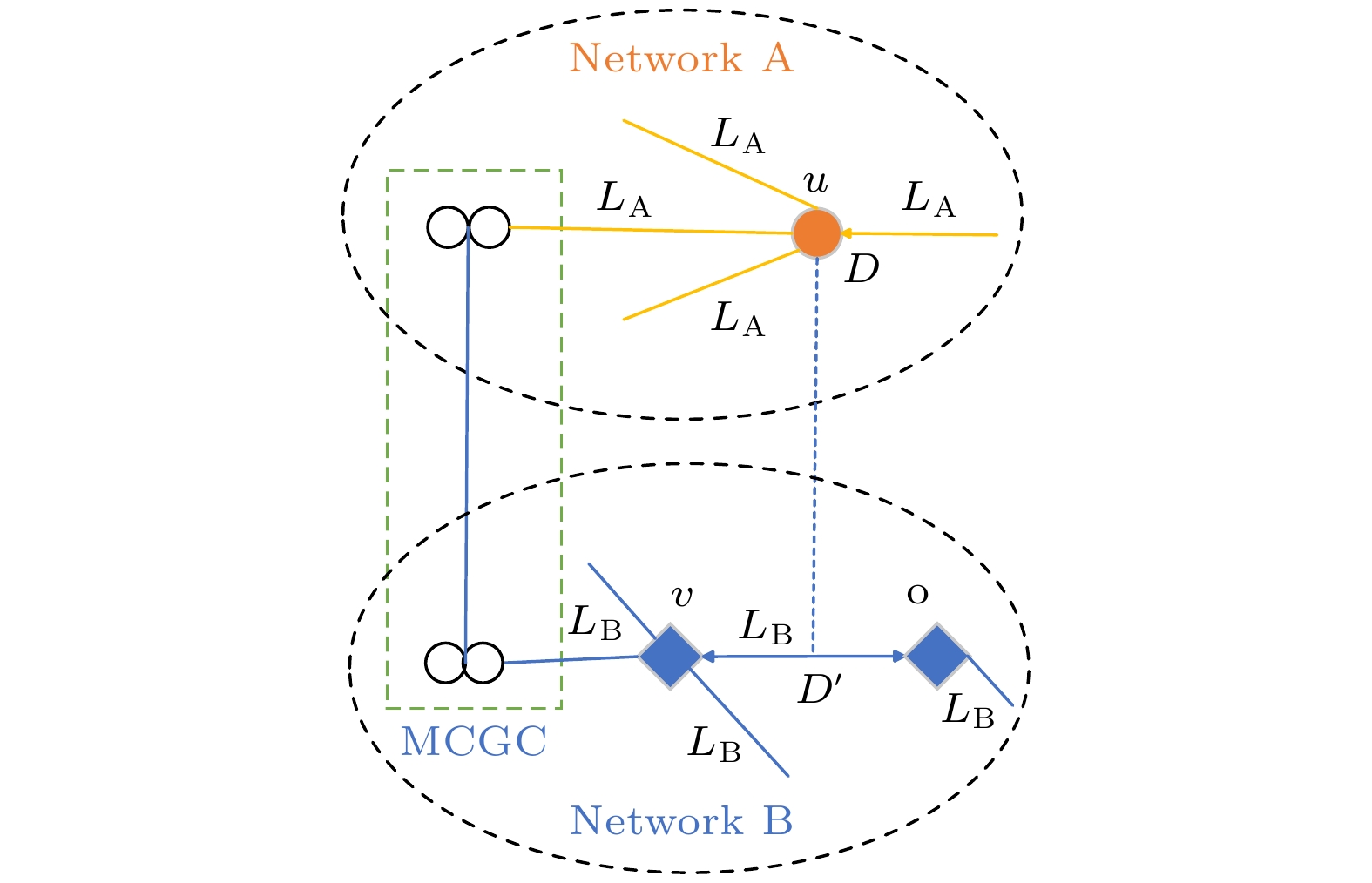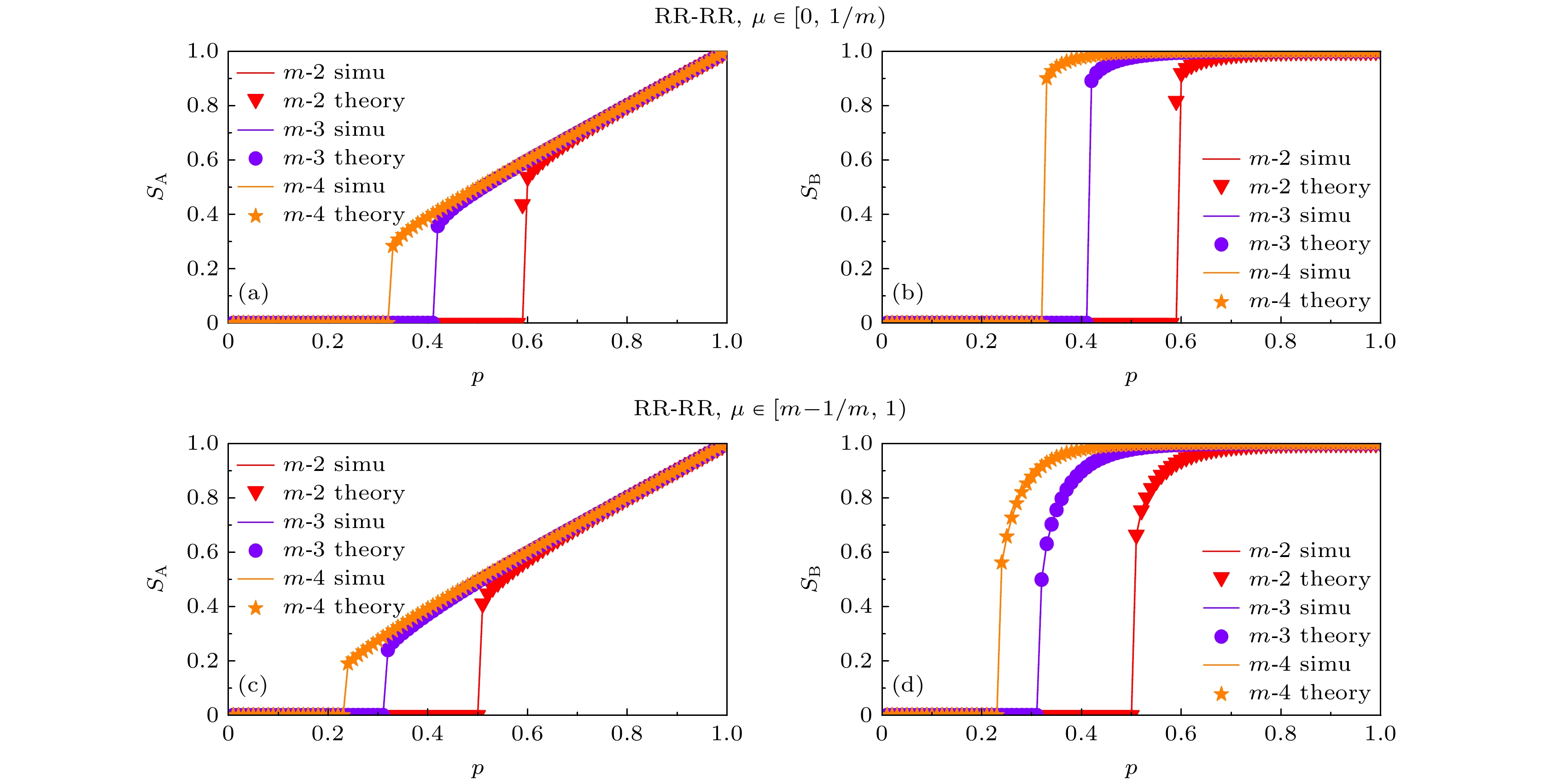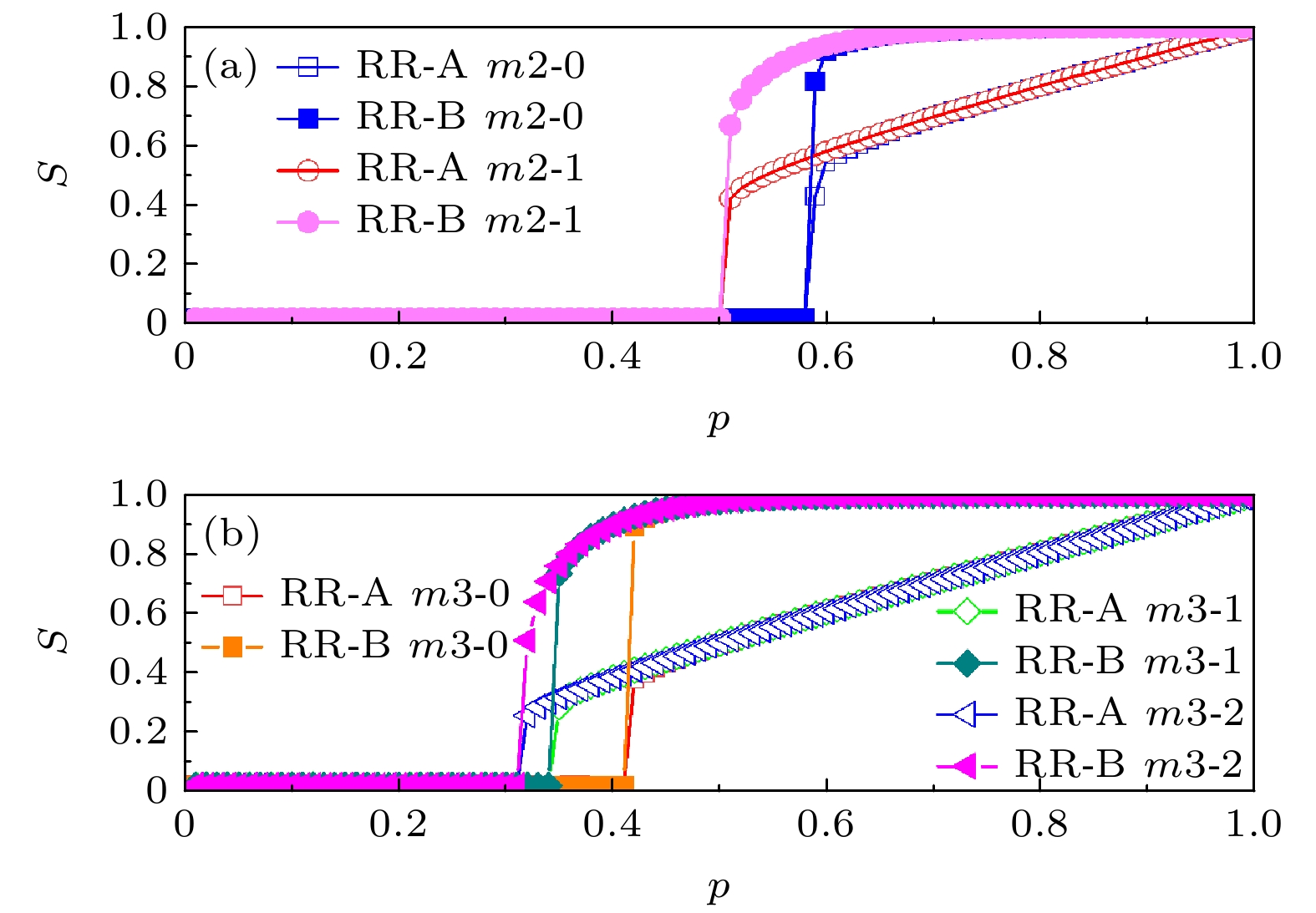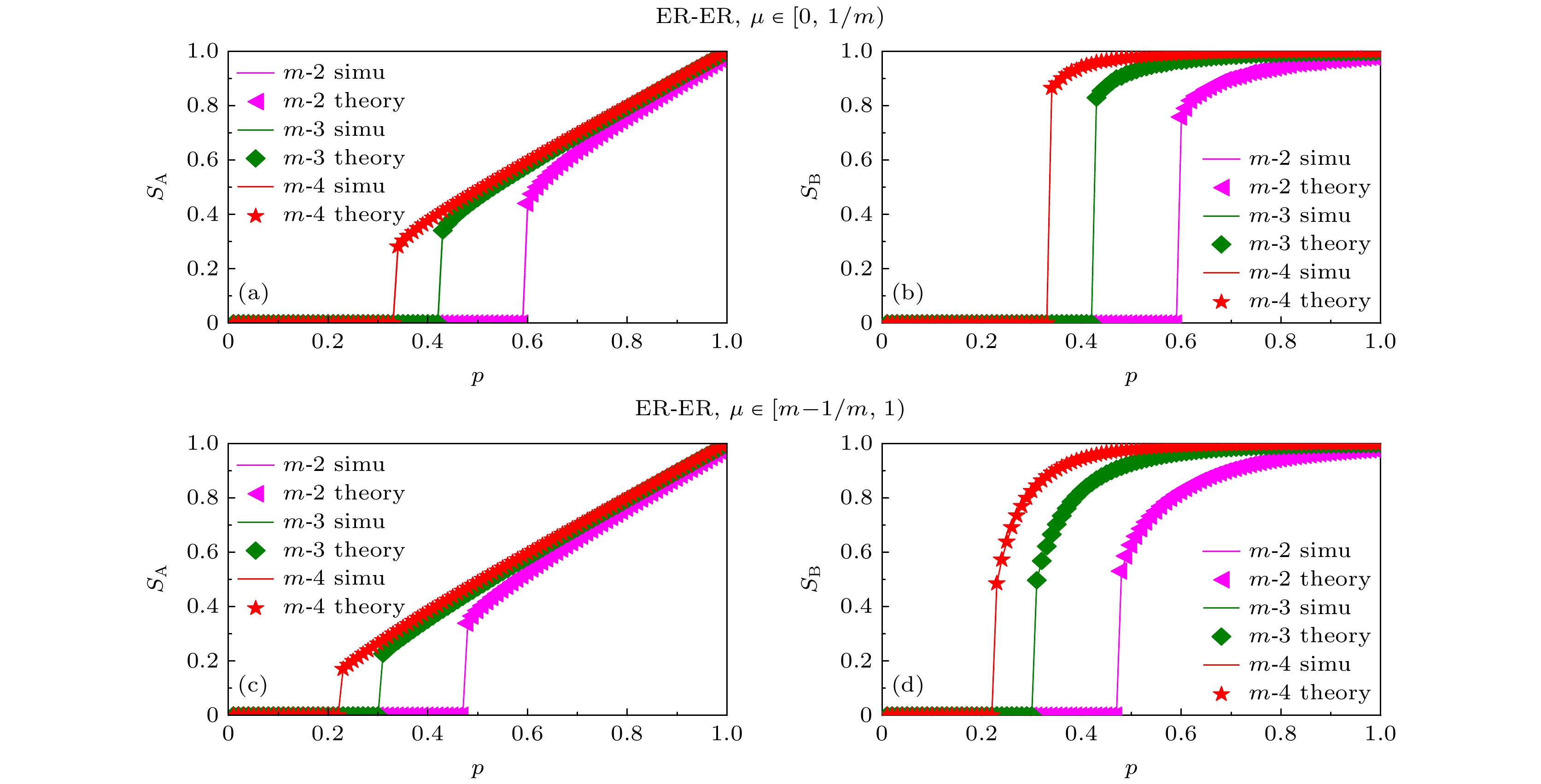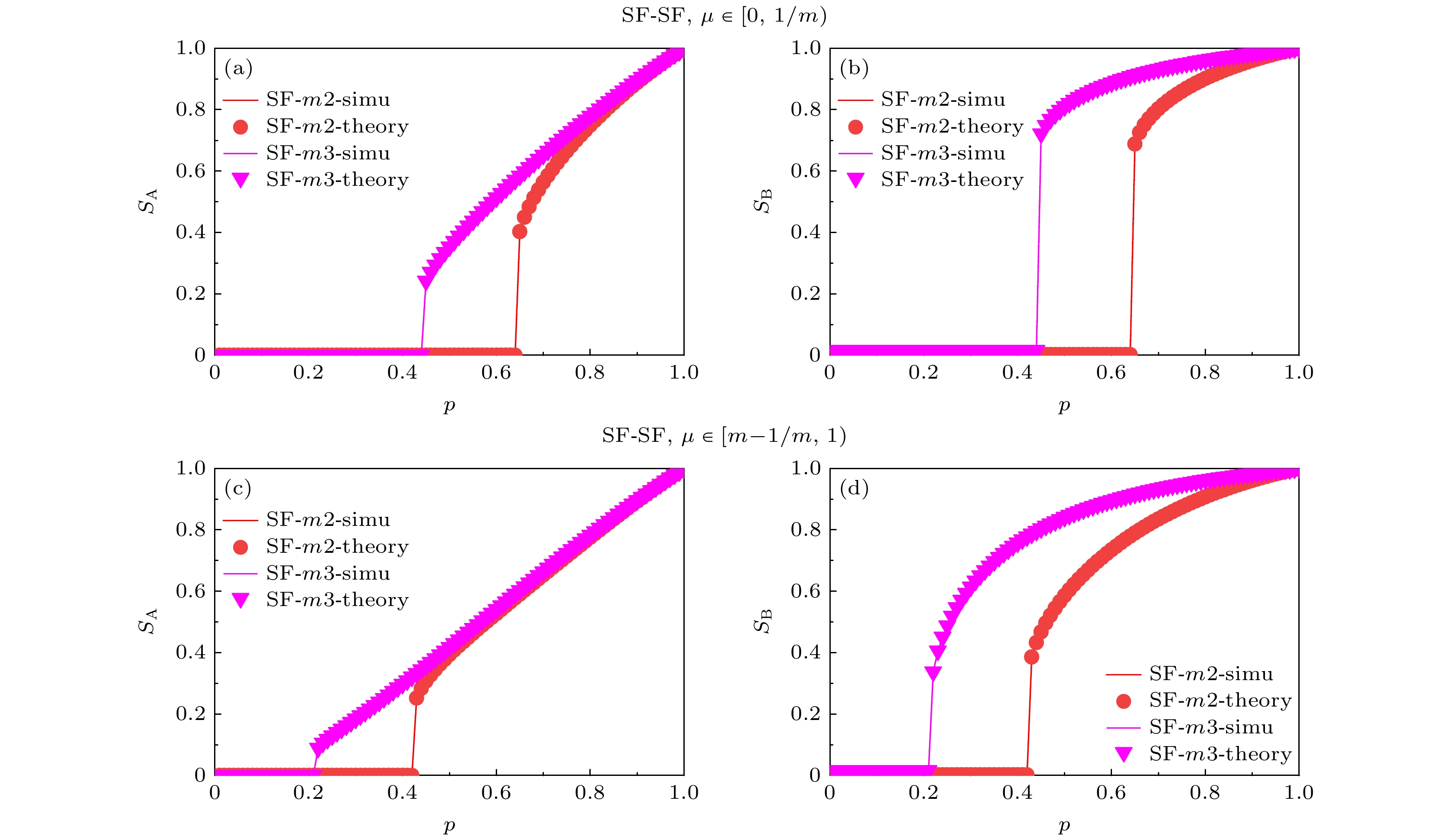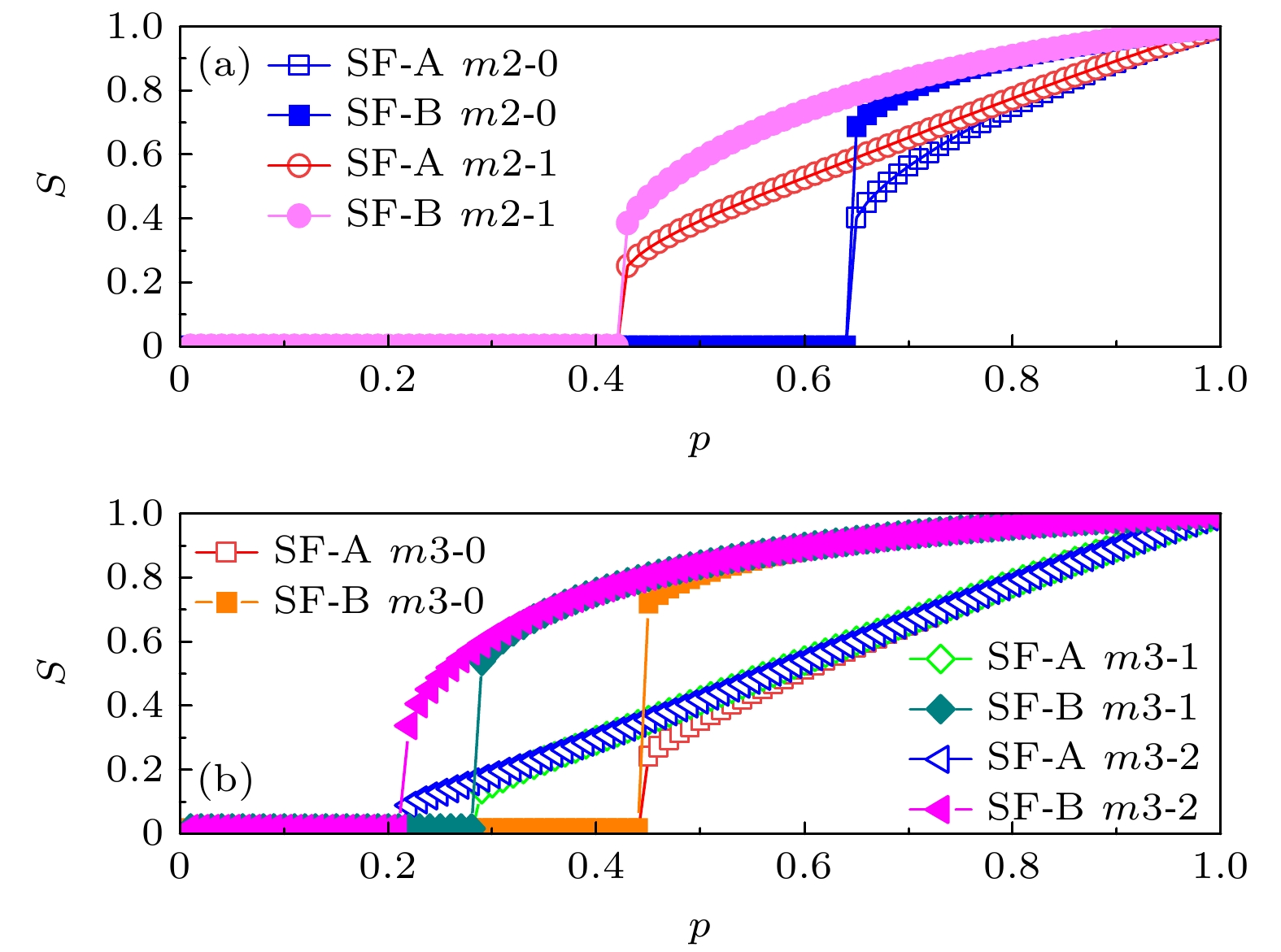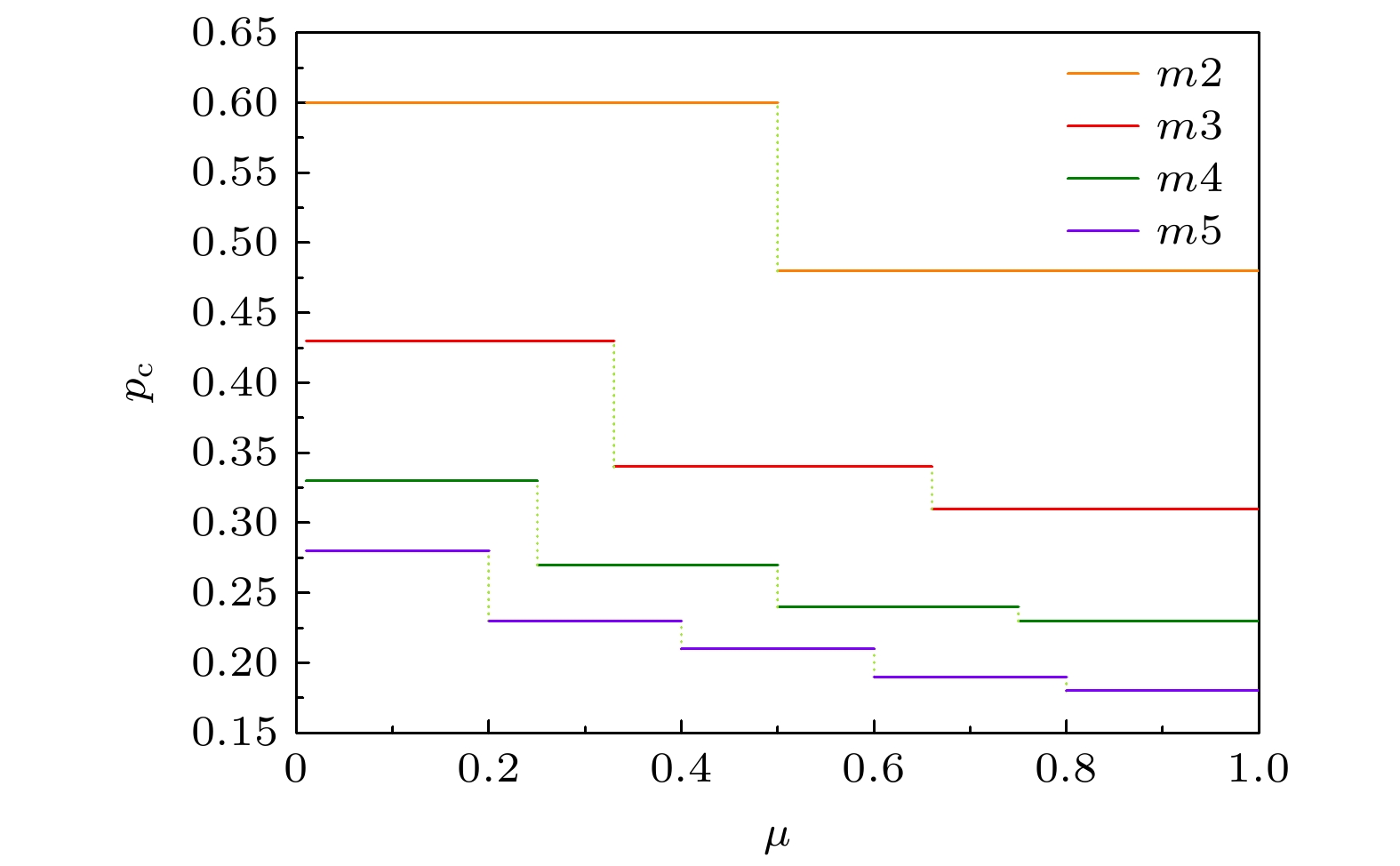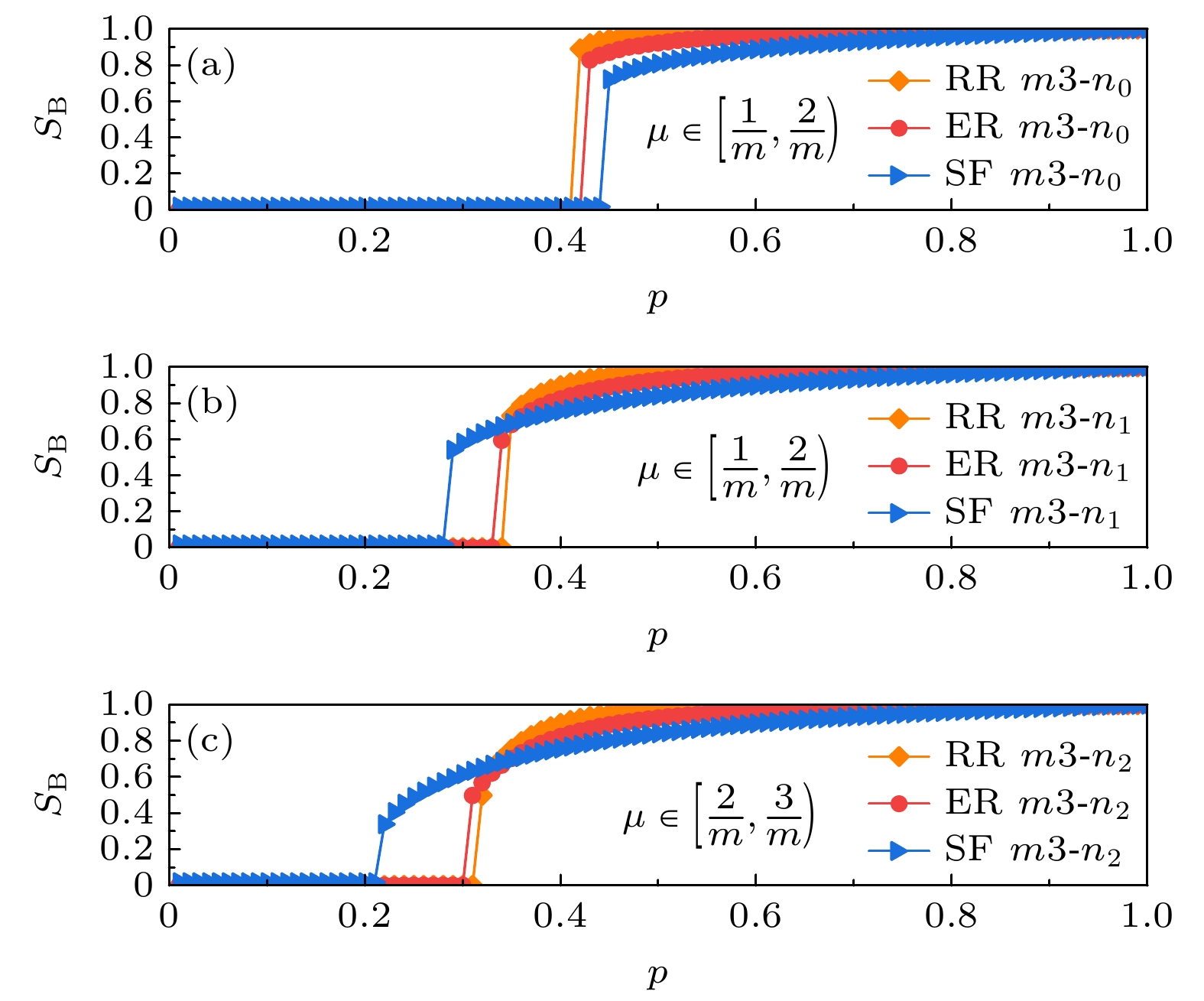-
本文建立了节点和连边耦合的二元相互依赖网络模型(binary interdependent networks with node and edge coupling, BINNEC). 该模型中, 网络A节点随机依赖网络B多条边从而形成边依赖群, 当边依赖群的失效比例超过网络失效容忍度
$\mu $ 时, 导致网络A的节点失效. 基于自平衡概率法建立起理论分析框架, 通过对3种经典网络结构下的BINNEC网络进行计算机仿真验证, 并分析了该模型面对随机攻击下的相变行为和关键阈值. 研究结果表明3种网络结构下的BINNEC网络和一元耦合网络一样脆弱, 网络的相变行为都是一阶相变. 当网络节点的边依赖群规模$m$ 越大, 网络鲁棒性增强; 在网络的边依赖群规模一定时, 节点的失效容忍度$\mu $ 越大网络鲁棒性越强. 本文进一步研究在$m$ 和$\mu $ 相同条件下, 网络的度分布对BINNEC的影响. 研究可以为此类二元耦合网络鲁棒性提供一定的理论依据, 同时也为现实网络的安全设计提供指导意义.Existing research on interdependent networks defines network functionality as being entirely on nodes or on edges, which means interdependence between nodes and nodes, or interdependence between edges and edges. However, the reality is not characterized solely by interdependence between functionalities of individual elements, which means that it is not entirely a single-element coupled network. In some cases, nodes and edges are interdependent. Considering this reality, a binary interdependent network model with node and edge coupling (BINNEC), where both nodes and edges are interdependent, is proposed in this work. In this model, nodes in network A randomly depend on multiple edges in network B, forming edge-dependent clusters. Additionally, a failure tolerance parameter, denoted as$\mu $ , is set for these edge-dependent clusters. When the failure rate of an edge-dependent cluster exceeds$\mu $ , the failure of the nodes in network A that depends on it, will happen. Based on the self-balancing probability method, a theoretical analysis framework is established. Through computer simulation verification of BINNEC under three classical network structures, the model's phase transition behavior and critical thresholds in the face of random attacks are analyzed. The results reveal that BINNEC under three network structures is as fragile as a single-element coupled network, exhibiting a first-order phase transition behavior. As the size of edge-dependent cluster$m$ increases, network robustness is enhanced. Moreover, with a constant size of edge-dependent cluster, a larger tolerance for node failure$\mu $ leads to stronger network robustness. Finally, this research reveals that under the same conditions of$m$ and$\mu $ , when the tolerance for node failure$\mu $ is insufficient to withstand the failure of a single edge, the degree distribution widens, and network robustness weakens. However, when the tolerance for node failure is sufficient to withstand the failure of at least one edge, the network robustness actually strengthens as the degree distribution increases. These findings provide a theoretical basis for studying such binary coupled models and also for guiding the secure design of real-world networks.-
Keywords:
- interdependent networks /
- binary coupling /
- failure tolerance /
- robustness
[1] Crucitti P, Latora V, Marchiori M 2004 Phys. Rev. E 69 045104
 Google Scholar
Google Scholar
[2] Mirzasoleiman B, Babaei M, Jalili M, Safari M 2011 Phys. Rev. E 84 046114
 Google Scholar
Google Scholar
[3] Wang J W, Rong L L, Zhang L, Zhang Z Z 2008 Physica A 387 6671
 Google Scholar
Google Scholar
[4] Panzieri S, Setola R 2008 Int. J. Model. Identif Control 3 69
 Google Scholar
Google Scholar
[5] Adenso-Díaz B, Mar-Ortiz J, Lozano S 2018 Int. J. Prod. Res. 56 5104
 Google Scholar
Google Scholar
[6] Yao H G, Xiao H H, Wei W 2022 Discret. Dyn. Nat. Soc. 23 49523
 Google Scholar
Google Scholar
[7] Rosato V, Issacharoff L, Tiriticco F, Meloni S, Porcellinins S D, Setola R 2008 Int. J. Crit. Infrastruct. 4 63
 Google Scholar
Google Scholar
[8] Buldyrev S V, Parshani R, Paul G, Stanley H E, Havlin S 2010 Nature 464 1025
 Google Scholar
Google Scholar
[9] Hu B, Li F, Zhou H S 2009 Chin. Phys. Lett. 26 128901
 Google Scholar
Google Scholar
[10] Mizutaka S, Yakubo K 2015 Phys. Rev. E 92 012814
 Google Scholar
Google Scholar
[11] Li J, Wu J, Li Y, Deng H Z, Tan Y J 2011 Chin. Phys. Lett. 28 058904
 Google Scholar
Google Scholar
[12] Parshani R, Buldyrev S V, Havlin S 2010 Phys. Rev. Lett. 105 048701
 Google Scholar
Google Scholar
[13] Dong G G, Gao J X, Tian L X, Du R J, He Y H 2012 Phys. Rev. E 85 016112
 Google Scholar
Google Scholar
[14] Gao J X, Buldyrev S V, Havlin S, Stanley E 2011 Phys. Rev. Lett. 107 195701
 Google Scholar
Google Scholar
[15] Jiang W, Liu R, Jia C 2020 Complexity 2020 3578736
 Google Scholar
Google Scholar
[16] Zhang H, Zhou J, Zou Y, Tan M, Xiao G X, Stanley H Z 2020 Phys. Rev. E 101 022314
 Google Scholar
Google Scholar
[17] Dong G, Chen Y, Wang F, Du R J, Tian L X, Stanley H E 2019 Chaos 29 073107
 Google Scholar
Google Scholar
[18] 韩伟涛, 伊鹏 2019 物理学报 68 078902
 Google Scholar
Google Scholar
Han W T, Yi P 2019 Acta Phys. Sin. 68 078902
 Google Scholar
Google Scholar
[19] Wang Z X, Zhou D, Hu Y Q 2018 Phys. Rev. E 97 032306
 Google Scholar
Google Scholar
[20] Gao Y L, Chen S M, Zhou J, Stanley H E, Gao J 2021 Physica A 580 126136
 Google Scholar
Google Scholar
[21] Gao Y L, Yu H B, Zhou J, Zhou Y Z, Chen S M 2023 Chin. Phys. B 32 098902
 Google Scholar
Google Scholar
[22] Zhao Y Y, Zhou J, Zou Y, Guan S G, Gao Y L 2022 Chaos Solitons Fractals 156 111819
 Google Scholar
Google Scholar
[23] Xie Y F, Sun S W, Wang L, Xia C Y 2023 Phys. Lett. A 483 129063
 Google Scholar
Google Scholar
-
-
[1] Crucitti P, Latora V, Marchiori M 2004 Phys. Rev. E 69 045104
 Google Scholar
Google Scholar
[2] Mirzasoleiman B, Babaei M, Jalili M, Safari M 2011 Phys. Rev. E 84 046114
 Google Scholar
Google Scholar
[3] Wang J W, Rong L L, Zhang L, Zhang Z Z 2008 Physica A 387 6671
 Google Scholar
Google Scholar
[4] Panzieri S, Setola R 2008 Int. J. Model. Identif Control 3 69
 Google Scholar
Google Scholar
[5] Adenso-Díaz B, Mar-Ortiz J, Lozano S 2018 Int. J. Prod. Res. 56 5104
 Google Scholar
Google Scholar
[6] Yao H G, Xiao H H, Wei W 2022 Discret. Dyn. Nat. Soc. 23 49523
 Google Scholar
Google Scholar
[7] Rosato V, Issacharoff L, Tiriticco F, Meloni S, Porcellinins S D, Setola R 2008 Int. J. Crit. Infrastruct. 4 63
 Google Scholar
Google Scholar
[8] Buldyrev S V, Parshani R, Paul G, Stanley H E, Havlin S 2010 Nature 464 1025
 Google Scholar
Google Scholar
[9] Hu B, Li F, Zhou H S 2009 Chin. Phys. Lett. 26 128901
 Google Scholar
Google Scholar
[10] Mizutaka S, Yakubo K 2015 Phys. Rev. E 92 012814
 Google Scholar
Google Scholar
[11] Li J, Wu J, Li Y, Deng H Z, Tan Y J 2011 Chin. Phys. Lett. 28 058904
 Google Scholar
Google Scholar
[12] Parshani R, Buldyrev S V, Havlin S 2010 Phys. Rev. Lett. 105 048701
 Google Scholar
Google Scholar
[13] Dong G G, Gao J X, Tian L X, Du R J, He Y H 2012 Phys. Rev. E 85 016112
 Google Scholar
Google Scholar
[14] Gao J X, Buldyrev S V, Havlin S, Stanley E 2011 Phys. Rev. Lett. 107 195701
 Google Scholar
Google Scholar
[15] Jiang W, Liu R, Jia C 2020 Complexity 2020 3578736
 Google Scholar
Google Scholar
[16] Zhang H, Zhou J, Zou Y, Tan M, Xiao G X, Stanley H Z 2020 Phys. Rev. E 101 022314
 Google Scholar
Google Scholar
[17] Dong G, Chen Y, Wang F, Du R J, Tian L X, Stanley H E 2019 Chaos 29 073107
 Google Scholar
Google Scholar
[18] 韩伟涛, 伊鹏 2019 物理学报 68 078902
 Google Scholar
Google Scholar
Han W T, Yi P 2019 Acta Phys. Sin. 68 078902
 Google Scholar
Google Scholar
[19] Wang Z X, Zhou D, Hu Y Q 2018 Phys. Rev. E 97 032306
 Google Scholar
Google Scholar
[20] Gao Y L, Chen S M, Zhou J, Stanley H E, Gao J 2021 Physica A 580 126136
 Google Scholar
Google Scholar
[21] Gao Y L, Yu H B, Zhou J, Zhou Y Z, Chen S M 2023 Chin. Phys. B 32 098902
 Google Scholar
Google Scholar
[22] Zhao Y Y, Zhou J, Zou Y, Guan S G, Gao Y L 2022 Chaos Solitons Fractals 156 111819
 Google Scholar
Google Scholar
[23] Xie Y F, Sun S W, Wang L, Xia C Y 2023 Phys. Lett. A 483 129063
 Google Scholar
Google Scholar
计量
- 文章访问数: 4304
- PDF下载量: 66
- 被引次数: 0


















 下载:
下载:

